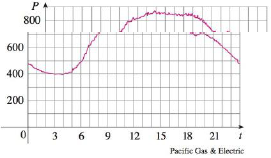
The graph shows the power consumption for a day in September in San Francisco. (P is measured in megawatts; t is measured in hours starting at midnight.)
(a) What was the power consumption at 6 AM? At 6 PM?
(b) When was the power consumption the lowest? When was it the highest? Do these times seem reasonable?

(a)
The power consumption at 6 am and at 6 pm.
Answer to Problem 13E
The power consumption at 6 am is 500 MW and at 6 pm is approximate to 730MW.
Explanation of Solution
In the given graph of power consumption for a day in September in San Francisco, the x-axis represents the time in hours and the y-axis represents the power consumption in megawatts.
From the graph, it is noticed that 6 am corresponds to the y-value of 500 MW. Thus, the power consumption at 6 am is 500 MW.
Similarly, it is found that the corresponding value of y-axis at 6 pm is lower than 740 MW and higher than 720 MW, and hence the power consumption is approximately 730 MW.
Thus, the power consumption at 6 pm is 730 MW.
(b)
At what time the power consumption was low and high; also state whether these time seems to be reasonable or not.
Answer to Problem 13E
The lowest power consumption occurs at 4 am and the highest power consumption occurs at just before noon.
The power consumption according to the time seems to be reasonable.
Explanation of Solution
From the given graph, it is obvious that the value of y is minimum at t = 4. Therefore, the lowest power consumption occurs at 4 am.
From the given graph, it is found that the value of y is maximum at t ≈ 12. Therefore, the highest power consumption occurs at just before noon.
By considering the individuals and business needs, the time of the lowest and the highest power consumptions are seems to be reasonable.
Chapter 1 Solutions
Single Variable Calculus: Concepts and Contexts, Enhanced Edition
Additional Math Textbook Solutions
Calculus 2012 Student Edition (by Finney/Demana/Waits/Kennedy)
Precalculus: Mathematics for Calculus (Standalone Book)
Calculus Early Transcendentals, Binder Ready Version
University Calculus: Early Transcendentals (3rd Edition)
University Calculus
Calculus For The Life Sciences
 Calculus: Early TranscendentalsCalculusISBN:9781285741550Author:James StewartPublisher:Cengage Learning
Calculus: Early TranscendentalsCalculusISBN:9781285741550Author:James StewartPublisher:Cengage Learning Thomas' Calculus (14th Edition)CalculusISBN:9780134438986Author:Joel R. Hass, Christopher E. Heil, Maurice D. WeirPublisher:PEARSON
Thomas' Calculus (14th Edition)CalculusISBN:9780134438986Author:Joel R. Hass, Christopher E. Heil, Maurice D. WeirPublisher:PEARSON Calculus: Early Transcendentals (3rd Edition)CalculusISBN:9780134763644Author:William L. Briggs, Lyle Cochran, Bernard Gillett, Eric SchulzPublisher:PEARSON
Calculus: Early Transcendentals (3rd Edition)CalculusISBN:9780134763644Author:William L. Briggs, Lyle Cochran, Bernard Gillett, Eric SchulzPublisher:PEARSON Calculus: Early TranscendentalsCalculusISBN:9781319050740Author:Jon Rogawski, Colin Adams, Robert FranzosaPublisher:W. H. Freeman
Calculus: Early TranscendentalsCalculusISBN:9781319050740Author:Jon Rogawski, Colin Adams, Robert FranzosaPublisher:W. H. Freeman
 Calculus: Early Transcendental FunctionsCalculusISBN:9781337552516Author:Ron Larson, Bruce H. EdwardsPublisher:Cengage Learning
Calculus: Early Transcendental FunctionsCalculusISBN:9781337552516Author:Ron Larson, Bruce H. EdwardsPublisher:Cengage Learning





